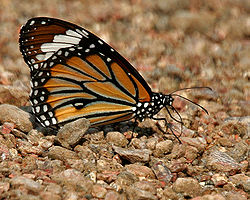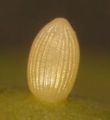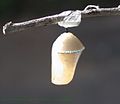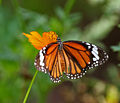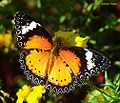- Danaus genutia
-
Common Tiger 
At Bangalore, India Scientific classification Kingdom: Animalia Phylum: Arthropoda Class: Insecta Order: Lepidoptera Family: Nymphalidae Tribe: Danaini Genus: Danaus Species: D. genutia Binomial name Danaus genutia
Cramer, 1779The Common Tiger (Danaus genutia) is one of the common butterflies of India. It belongs to the "Crows and Tigers", that is, the danainae group of the Brush-footed butterflies family. The butterfly is also called Striped Tiger in India to differentiate it from the equally common Plain Tiger Danaus chrysippus.[1]
Contents
Description
The butterfly closely resembles the Monarch butterfly (Danaus plexippus) of the Americas. The wingspan is 75 to 95 mm. Both sexes of the butterfly have tawny wings with veins marked with broad black bands. The female[verification needed] has a pouch on the hindwing[2]. The margins of the wings are black with two rows of white spots. The underside of the wings resembles the upperside but is paler in colouration. The male Common Tiger has a prominent black-and-white spot on the underside of the hindwing.[1] In drier regions the tawny part of the hindwing pales and approaches white in colour making it very similar to the White Tiger (D. melanippus).[2]
- Subspecies
It has some 16 subspecies; its evolutionary relationships are not completely resolved, but it appears to be closest to the Malay Tiger (D. affinis) and White Tiger.[3]
Distribution and ecology
D. genutia is distributed throughout India, Sri Lanka, Myanmar and extending to South East Asia and Australia (except New Guinea)[1]. At least in the South Asian part of its range it is fairly common, locally very common[2]. This butterfly occurs in scrub jungles, fallowland adjacent to habitation, dry and moist deciduous forests, preferring areas of moderate to heavy rainfall. Also occurs in degraded hill slopes and ridges, both, bare or denuded, and, those covered with secondary growth.[1] While it is a strong flier, it never flies rapidly or high. It has stronger and faster strokes than the Plain Tiger. The butterfly ranges forth in search of its host and nectar plants. It visits gardens where it nectars on the flowers of Adelocaryum, Cosmos, Celosia, Lantana, Zinnia and similar flowers.[1]
Defence against predators, mimicry
Members of this genus are leathery, tough to kill and fake death. Since they are unpleasant to smell and taste, they are soon released by the predators, recover and fly off soon thereafter. The butterfly sequesters toxins from its foodplants of the family Asclepiadaceae. The butterflies also congregate with other danaiines to sip from the sap of Crotolaria, Heliotropium and other plants which provide the pyrrrolizidine alkaloids which they sequester[1]. A study in Northeastern India showed a preference to foraging on Crotalaria juncea compared to Bauhinia purpurea, Barleria cristata rosea and Nerium oleander[4]. To advertise their unpalatability, the butterfly has prominent markings with a striking colour pattern. The Striped Tiger is mimicked by both sexes of the Indian Tamil Lacewing Cethosia nietneri mahratta and the Leopard Lacewing Cethosia cyane and females of the Common Palmfly Elymnias hypermnestra.[5]
Life history
This butterfly lays its egg singly under the leaves of any of its hostplants of family Asclepiadaceae. The caterpillar is black and marked with bluish-white and yellow spots and lines. It has three pairs of tentacles on its body. It first eats the eggshell and then proceeds to eat leaves and vegetative parts of the plant. The chrysalis (pupa) is green and marked with golden yellow spots.[1]
Gallery
-
Female on Eupatorium odoratum at Jayanti in Buxa Tiger Reserve in Jalpaiguri district of West Bengal, India.
-
in Hyderabad, India.
-
Female at Narendrapur near Kolkata, India.
-
Female on Mikania micrantha (Bittervine, Chinese creeper) at Narendrapur near Kolkata, West Bengal, India.
-
D. genutia (Underside) in Kolkata, West Bengal, India.
-
Leopard Lacewing (Cethosia cyane) in Namdapha National Park, Arunachal Pradesh, India]]
-
From Taliparamba, Kerala
Food plants
The caterpillar of the Common Tiger butterfly obtains a supply of poison by eating poisonous plants, which makes the caterpillar and butterfly a distasteful morsel for predators. The most common foodplants of the Common Tiger in Peninsular India are small herbs, twiners and creepers from the family Asclepiadaceae, including:
- Asclepias curassavica[1]
- Ceropegia intermedia[1][6]
- Cynanchum dalhousieae[6]
- Raphistemma pulchellum[6]
- Stephanotis spp.[1] (including S. floribunda?[6])
- Tylophora tenuis[1]
See also
References
- Bhuyan, M.; Deka, M.; Kataki, D. & Bhattacharyya, P. R. (2005): Nectar host plant selection and floral probing by the Indian butterfly Danaus genutia (Nymphalidae). Journal of Research on the Lepidoptera 38: 79-84. PDF fulltext
- Evans, W.H. (1932) The Identification of Indian Butterflies. (2nd Ed), Bombay Natural History Society, Mumbai, India.
- Kunte, Krushnamegh (2000) Butterflies of Peninsular India, Universities Press (India) Ltd, Hyderabad (reprint 2006). ISBN 81-7371-354-5
- Smith, David A. S.; Lushai, Gugs & Allen, John A. (2005): A classification of Danaus butterflies (Lepidoptera: Nymphalidae) based upon data from morphology and DNA. Zool. J. Linn. Soc. 144(2): 191–212. doi:10.1111/j.1096-3642.2005.00169.x (HTML abstract)
- Wynter-Blyth, M. A. (1957): Butterflies of the Indian Region. Bombay Natural History Society, Mumbai, India.
Footnotes
External links
Categories:- Danaus
- Insects of Pakistan
- Butterflies of India
- Fauna of Sri Lanka
- Butterflies and moths of Asia
Wikimedia Foundation. 2010.


